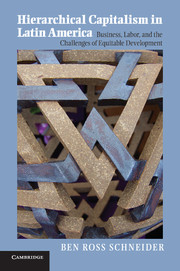 Hierarchical Capitalism in Latin America
Hierarchical Capitalism in Latin America Book contents
- Frontmatter
- Contents
- List of Figures
- List of Tables
- Abbreviations
- Preface
- Part I Theory and Frames
- Part II Business, Labor, and Institutional Complementarities
- Part III Politics, Policy, and Development Strategy
- 7 Business-Group Politics: Institutional Bias and Business Preferences
- 8 Twenty-First-Century Variations
- 9 Conclusions
- Appendix Interviews
- References
- Index
8 - Twenty-First-Century Variations
Divergence and Possible Escape Trajectories
Published online by Cambridge University Press: 05 August 2013
- Frontmatter
- Contents
- List of Figures
- List of Tables
- Abbreviations
- Preface
- Part I Theory and Frames
- Part II Business, Labor, and Institutional Complementarities
- Part III Politics, Policy, and Development Strategy
- 7 Business-Group Politics: Institutional Bias and Business Preferences
- 8 Twenty-First-Century Variations
- 9 Conclusions
- Appendix Interviews
- References
- Index
Summary
Introduction
While pushing the notion of a single ideal type of hierarchical capitalism for Latin America, previous chapters also noted exceptions and deviations. This chapter takes the analysis of variation a step further by examining recent trends in four countries. Mexico (Colombia could be included as well) offers a benchmark of continuity on all four dimensions of hierarchical capitalism: business groups, MNCs, segmented and atomized labor markets, and a low-skill equilibrium. Argentina, in contrast, starts to move away from the ideal type in the 1990s (with the demise of many business groups), and in the 2000s, the Kirschners’ heterodox economic policies and support for labor unions furthered the trend. Brazil and Chile appeared by the 2000s to have the greatest potential for escaping the middle-income trap in part by using technology and education policy to counter the negative complementarities of hierarchical capitalism.
Sources of intraregional variation are many, ranging from colonial legacies (Mahoney 2010), to geography (Engerman and Sokoloff 2012), to contemporary economic and political trends, the focus of this chapter. At the start of the twenty-first century, two major trends – the boom in natural resources and the leftward shift in politics – buffeted the region, although variably across countries. For example, by the late 2000s, international demand for exports was putting countries of the region on two separate tracks. Stagnation in the United States depressed exports and growth in Mexico, Central America, and the Caribbean, while booming Asian demand for food and minerals fueled higher growth across most of South America (Izquierdo and Talvi 2011).
- Type
- Chapter
- Information
- Hierarchical Capitalism in Latin AmericaBusiness, Labor, and the Challenges of Equitable Development, pp. 160 - 184Publisher: Cambridge University PressPrint publication year: 2013
